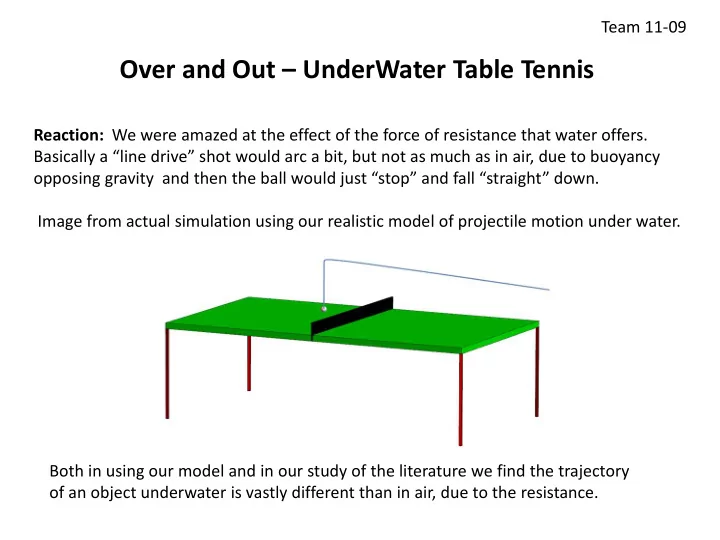

Team 11-09 Over and Out – UnderWater Table Tennis Reaction: We were amazed at the effect of the force of resistance that water offers. Basically a “line drive” shot would arc a bit, but not as much as in air, due to buoyancy opposing gravity and then the ball would just “stop” and fall “straight” down. Image from actual simulation using our realistic model of projectile motion under water. Both in using our model and in our study of the literature we find the trajectory of an object underwater is vastly different than in air, due to the resistance.
Team 11-09 Over and Out – UnderWater Table Tennis We use a steel ball of radius 1.2 cm, a paddle strung like a tennis racquet about the size of a table tennis paddle, and a concrete table of the same dimensions as a regulation table tennis court: 274 cm long, 152.5 cm wide, 152 cm high. Our centered net is 45.25 cm high. Which is three times the height in regulation court. This is to force the players to hit the ball high so when it lands on the opponent’s side, near the edge of the table it will have sufficient velocity to bounce back and off the table, not just “dribble” on the table. The table is at the bottom of a flat pool in 2.5 m (250 cm) of fresh water. The racquet must be porous to permit imparting high initial velocity to the ball by the hitter in order to clear the high net and get near the table’s edge on the opponent’s side of the table. 11 points wins the game. We have three rules. (1) If ball breaches the surface of the water the striker loses the point. (2) Ball must strike the opponent’s side of the table first every play. (3) After ball strikes the opponent’s side of the table once it must bounce off the table surface.
Free Body Diagram for Table Tennis Mass (Green) Use Newton’s Second Law of Motion Force due to buoyancy Mass times acceleration of a body is equal to the sum of the external forces acting on the body. Force due to resistance Force due to gravity We now need to get our signs right by paying attention to an axes system and orientation.
Force due to buoyancy Here Force due to resistance Force due to gravity We note that a is the only parameter which can not be directly measured and so must be estimated from data.
We used the differential equation throughout. We conducted an experiment dropping a dense rubber ball in a graduated cylinder with an online digital timer. Knowing all other parameters we were able to estimate a = 119.86 dyne/(cm/s). A model with resistance proportional to velocity squared gave comparable results. We used the same a value with our steel ball.
View of Initial Server on the right and Return of Service on the Left Water surface Server’s flight Net S Ball bouncing Server near edge of table and then being struck in return of service. Relative to point C = (0, 0, 0) at center of net on surface of table we have original position of ball on server’s side of net (right) at Point S = (144.5, 7.5, 91.0) cm with first coordinate giving left-right position, second coordinate giving back to front position, and third coordinate giving height from the base of the table.
Water surface Server’s flight Ball bouncing near edge of table Server and then being struck in return of Net service. Server imparts initial velocity (-648.208, 0, 737.616) cm/s. This is one quarter of maximum speed a table tennis player on land can impart to the ball in that game. Ball lands on opponent’s side of the table at point ( -134.68, 7.5, 77.2) cm while edge of table is at (-137, 7.5, 77.2) cm. So we land the ball near the edge. HERE COMES OVER AND OUT Ball bounces off the table and is struck by opponent when it arrives at a point (- 143.94, 7.5, 68.13) cm just off and below the edge of opponent’s side of the table.
Equipment Needs and Fine Rules: We offer some suggestions about equipment. Players will need • small air tank for mobility, • goggles for unblurred vision of the ball and table, • perhaps extra weight “clips” to keep player grounded. We presume alternate service in this short 11 point game and each service produces a point.
Conclusions: This is a game of skill in placement of the shot by each player, for the ball has to land near the back edge of the opponent’s side of the table and THEN bounce off so the opponent can get clear hit of the ball to return to the other side of the table. Timing – the time it takes, say from service to when the ball strikes the opponent’s table is about 1.25 s so players have to be agile and be able to move. Improvements: Consider other resistance terms than – a v’(t) and render better estimates of parameter a . We used the criterion that the a which minimized the sum of squared errors between our model solution of our differential equation model with parameter a as the only variable and our data from our rubber ball drop experiment. We could make the surface of the table smaller to permit smaller initial velocities, quicker responses by players to the motion of the ball. We could use other materials for the ball and the surface.
We would be glad to answer questions or engage in conversation. Thank you for your attention.
Recommend
More recommend